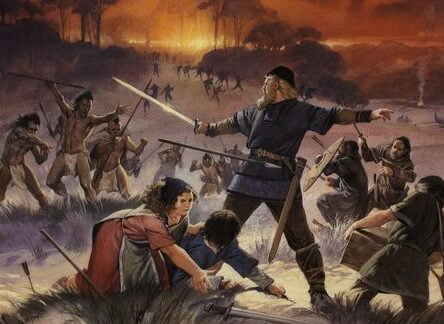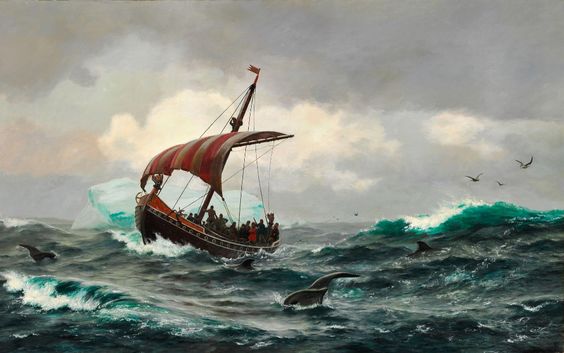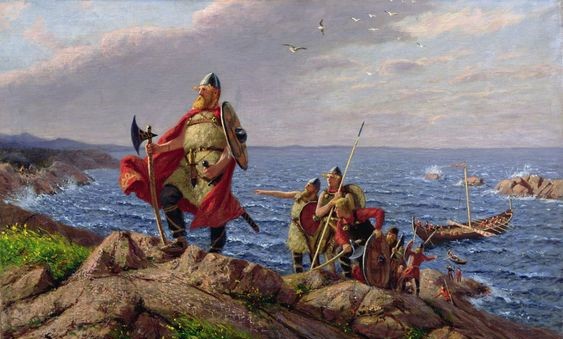
Long before Columbus’ voyage in 1492, Leif Erikson began his exploration of North America over a thousand years prior. Around 500 years before Christopher Columbus, a Norse adventurer named Leif Erikson, also known as Leif the Lucky, Leiv Eiriksson, or Leif Ericson, is thought to have been the first European to set foot on North American soil. Continue reading to learn more about the daring explorer.
The Way Americans Pronounce Leif Erickson’s Name Is Peculiar.
Leif typically rhymes with the English word safe (or like “life” depending on the region) and is pronounced “Layf” in Iceland and Scandinavia. However, in America, “Leef” is frequently used instead. You might recall Spongebob Squarepants praising “Leef” Erikson Day in a season two episode if you watched Nicktoons as a child. Leif’s name is also spelled in a variety of ways.
The name “Leif Erikson” is spelt “Leifr Eirksson” in Old Norse. However, it is written Leiv Eiriksson in Nynorsk, a more modern form of Norwegian writing. Just the top of the iceberg, really. Some authors use alternative spellings like Ericson, Eriksson, and Erikson, which might further complicate matters. Leif Erikson is the most frequently used variant in the United States, so we’ll stick with it.
Leif Erikson Was A Christian Missionary
Leif’s upbringing is not well described in the sagas, but he was most likely born in Iceland between 970 and 980 CE and raised in Greenland. Erik dispatched Leif to Norway in the year 999 CE so that he may serve as a royal bodyguard for King Olaf Tryggvason. Leif was an enthusiastic convert to Christianity who Tryggvason attracted by passionately promoting it. The monarch gave his bodyguard a particular assignment to spread Christianity in Greenland around 1000 or 1001 CE.
Leif spread the gospel when he returned to his father’s island, though not without difficulties. Thjodhild, his mother, quickly embraced the new religion. She also insisted on having a chapel constructed close to her house in Greenland. On the other hand, Erik the Red was adamant about his Pagan convictions. Thjodhild then stopped sleeping with him as retaliation, which one legend claims “was a huge trial to his temper.”

A Geographic Puzzle Was Left Back By Leif Erikson And The Vikings
The Vikings headed south once they were out of Helluland. Their next stop was a region covered in trees that came to be known as Markland, or “the land of wood.” According to the sagas, Markland was located north of a third region that the Nordics called Vinland and south of Helluland. Markland is generally believed to have been a section of Canada’s Labrador coast. We are aware that Greenlanders continued to go there well into the 1300s, wherever it was. This is due to the fact that a record from 1347 describes a ship that had just made a port call in Markland, albeit no precise information regarding its location is provided.
Vinland’s location is a complete mystery. The sagas describe it as a huge region with a valuable resource: grape vines. There were also rumored to be natural grasses, salmon, and game animals. Leif’s group established a settlement at Vinland, where they spent the winter before returning to Greenland. The Icelandic sagas recount further Viking incursions into Vinland. The Bishop of Greenland visited there in 1121 CE, according to other texts.
But eventually, the Nordic population stopped visiting Vinland. Even though historians disagree today regarding the location of the site, archaeologists discovered what turned out to be a Viking settlement in Newfoundland in 1960. The location is known as L’Anse aux Meadows, and radiometric dating indicates that it was constructed between 990 and 1030 CE and inhabited for roughly 10 years. That fits perfectly with the sequence of events in the Icelandic Sagas’ Leif’s account.
Is Vinland’s long-lost hamlet located near L’Anse aux Meadows? Maybe. Some analysts argue that it was merely a branch of that fabled colony and would have been used as a rest stop by seafarers. Others speculate that the location could be Markland rather than any region of Vinland.
Leif Erikson Stopped At Baffin Island Before Traveling To The Mainland.
Lemmings, caribou, and polar bears call the 932-mile-long island of Baffin, which is the largest in Canada, home (and people). It could possibly be one of the three regions of North America mentioned in the Icelandic Sagas.
In The Saga of the Greenlanders, as Leif’s soldiers set out on their westward trek, they quickly come across an ice landscape covered in big, flat boulders. Leif says in the book, “Now I will give the land a name, and call it Helluland.” The name translates from Old Norse as “stone-slab land.” Most historians believe that Helluland was actually Baffin Island based on the descriptions found in the sagas of the Greenlanders and Erik the Red. There have been several Norse artifacts discovered.
Leif Erikson’s Legacy And Later Life in Greenland
Erikson left Vinland and went back to Greenland; he would never again set foot on American soil. Though Leif was unable to persuade his father to accept Christianity, Thjodhild, who was the one who ordered the construction of Greenland’s first Christian church at Brattahild, was able to do so.
Leif Erikson succeeded Erik the Red as settlement chief after his death. Leif’s mother, with whom he never wed, sent their son Thorgils to live in Greenland, but he was reportedly unpopular. Thorkel Leifsson, a different (perhaps legitimate) son, succeeded his father as ruler by the year 1025. Regarding the descendants of Leif, nothing else is known.

Many Nordic Americans began to honor Leif Erikson as the first European explorer of the New World in the late 19th century. Erikson was the first European to discover America, President Calvin Coolidge declared to a Minnesota gathering in 1925, on the 100th anniversary of the first group of Norwegian immigrants to the country’s shores. Additionally, a legislative resolution passed by Congress in September 1964 gave President Lyndon B. Johnson the power to proclaim October 9 as “Leif Erikson Day.”
Also Read About Queen Elizabeth II